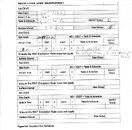Okay, I'm going to do this the "old fashioned way," using the U.S. Navy Diving Manual, Rev. 6.
http://www.usu.edu/scuba/navy_manual6.pdf
Page 9-58 gives the worksheet, and the tables are on subsequent pages.
If you dived for 5m (20 feet on the tables) for 90 minutes, you end on Repetitive Group "E," even though there is no limit for the dive. After 90 minutes, you are at the New Group of "A."
For the second dive, there was a surface interval of 3.5 hours, which put him into Repetitive Group "B." On the next dive, that gives a Residual Nitrogen Time of 8 minutes, to be added to the bottom time. Now, I had to extrapolate the bottom time because the dive computer said that for this dive, he had five minutes of no decompression limit time. The U.S. Navy Table 9-9 shows that the no decompression time for that dive is a maximum of 25 minutes. So I took the RNT of 8 minutes, plus 5 minutes shown on the computer, to give a bottom time of 12 minutes to have that 5 minutes left of no decompression time. But for this dive, this table shows a total ascent time of 3:20, and no stops required (although it is customary to take a safety stop anyway). The REPET Group at the end of this dive would be "H."
One of the things I have continued to do is to keep track of my bottom time independent of the dive computer. That way, I can reference back to the tables if I need to.
By the way, can't you print out your dive profile from that dive computer of yours? That would make looking at the dive much easier.
'Not sure this helps, but it was a good exercise for me, and a refamiliarization with the U.S. Navy Diving Manual's table for Revision 6.
SeaRat
http://www.usu.edu/scuba/navy_manual6.pdf
Page 9-58 gives the worksheet, and the tables are on subsequent pages.
If you dived for 5m (20 feet on the tables) for 90 minutes, you end on Repetitive Group "E," even though there is no limit for the dive. After 90 minutes, you are at the New Group of "A."
For the second dive, there was a surface interval of 3.5 hours, which put him into Repetitive Group "B." On the next dive, that gives a Residual Nitrogen Time of 8 minutes, to be added to the bottom time. Now, I had to extrapolate the bottom time because the dive computer said that for this dive, he had five minutes of no decompression limit time. The U.S. Navy Table 9-9 shows that the no decompression time for that dive is a maximum of 25 minutes. So I took the RNT of 8 minutes, plus 5 minutes shown on the computer, to give a bottom time of 12 minutes to have that 5 minutes left of no decompression time. But for this dive, this table shows a total ascent time of 3:20, and no stops required (although it is customary to take a safety stop anyway). The REPET Group at the end of this dive would be "H."
One of the things I have continued to do is to keep track of my bottom time independent of the dive computer. That way, I can reference back to the tables if I need to.
By the way, can't you print out your dive profile from that dive computer of yours? That would make looking at the dive much easier.
'Not sure this helps, but it was a good exercise for me, and a refamiliarization with the U.S. Navy Diving Manual's table for Revision 6.
SeaRat
Attachments
Last edited:





